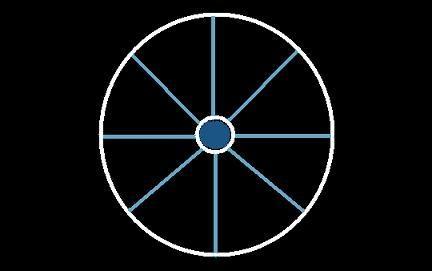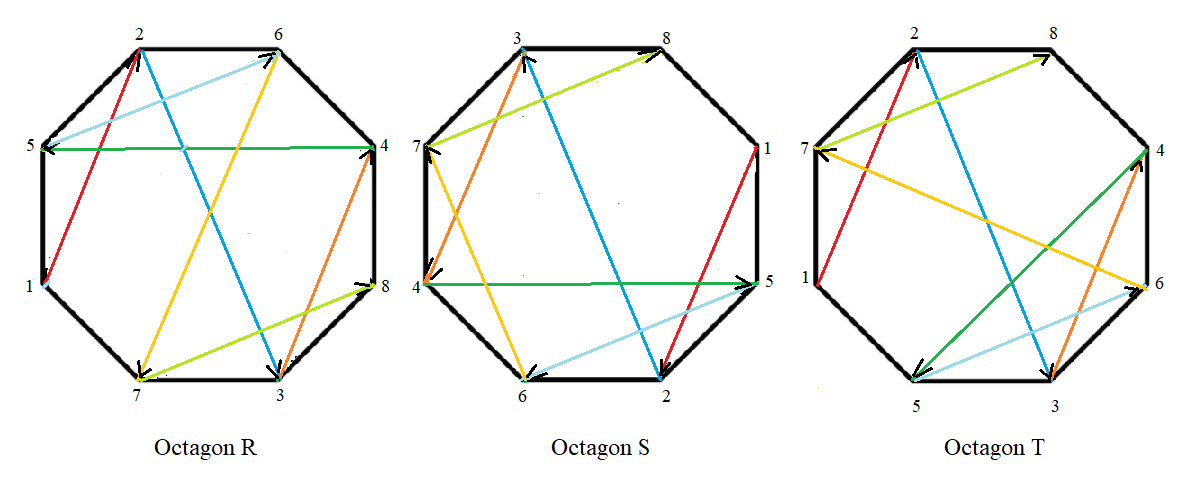Octagon Algorithm for Partial Border Wheel Squares (Part XVI)
The Eight Node Way - (a,c,e) Squares
The previous section Part XV mentioned that the graphs used in the octogonal algorithms differ in not having four centrally intersecting edges as in previous cases (see the A4 Partial Border square from 2015 Part I). Although the 3×3 internal border square was non magic the algorithms for producing this square were indeed different from those previously obtained. This section will depict the new (a,b,c) type squares specifically the 7th order squares and which algorithms to employ for the non spoke portions.
For the square to be partially bordered the internal 3×3 square is constructed using a triplet of numbers which produces a non magic 3×3 square. These triplets are labeled as (c,d,r) corresponding to the last cells in the central, diagonal and row spokes adjacent to the center cell in the square and are shown in Table Ic. The triplet in blue correspond to squares that are magic while those triplets in white correspond to triplets where the square is non magic or as the last one shows contains a spoke number:
Table Ic
| Odd c |
| 3,6,9 |
| 5,8,11 |
| 7,10,13 |
| 9,12,15 |
| 11,14,17 |
| 13,16,19 |
| 15,18,21 |
| 17,20,25 |
The 7×7 Wheel Squares
This section will deal with numbers (after the main diagonal is filled) that run in the order a (top center), c (bottom right) and e (left center) and whose 3×3 inner squares are filled with either of the four blue triplets from Table Ic. Only these triplets and none having a common number in the spokes are used.
The wheel portion of the square is filled according to Part X, using the blue color values from Table Ic. Because a square uses a 7×7 complementary table as a reservoir for the numbers used in a square, only adjacent pair of numbers, i.e., four adjacent numbers, are allowed if the square is to be magic. For instance, the complementary table for the first non magic square, 7d(5,8,11), where separately distant pairs of numbers (1,2) and 12,13) are present instead of two adjacent pairs of numbers, is non magic:
while those numbers in the complementary table that are linked together as two unsplittable pairs, for instance 7d(3,6,9), are partially border and magic.
Three algorithms are involved in the non spoke construction of the squares. The R and S algorithms fill in those cells on the perimeter of the 7×7 portion of the square while the T algorithm fills in the internal 5×5 portion. All three directed graph algorithms composed of two centrally intersecting edges are shown as follows:
To construct 7th order squares one simply fills in groups of four consecutive numbers the non spoke portions of the squares using the Octagon R and S algorithms for the outer cells
and the T algorithm for the inner cells. Below are shown the 7th order squares covering all seven triplets of Table Ic (blue and white) with the starting initial spoke numbers on the left hand side of the partial border square as was done for A4 from 2015 Part I:
Border 7d(3,6,9)
| 46 | 11 |
16 | 1 |
35 | 38 |
28 |
| 37 | 45 |
19 | 2 |
32 | 27 | 13 |
| 36 | 31 |
44 | 3 |
26 | 21 | 14 |
| 7 | 8 |
9 | 25 |
41 | 42 |
43 |
| 17 | 18 |
24 | 47 |
6 | 30 | 33 |
| 10 | 23 |
29 | 48 |
20 | 5 | 40 |
| 22 | 39 |
34 | 49 |
15 | 12 | 4 |
|
|
Non-Magic 7d(5,8,11)
| 44 | 2 |
16 | 3 |
35 | 38 |
28 |
| 37 | 43 |
19 | 4 |
32 | 27 | 13 |
| 36 | 31 |
42 | 5 |
26 | 21 | 14 |
| 9 | 10 |
11 | 25 |
39 | 40 |
41 |
| 17 | 18 |
24 | 45 |
8 | 30 | 33 |
| 1 | 23 |
29 | 46 |
20 | 7 | 49 |
| 22 | 48 |
34 | 47 |
15 | 12 | 6 |
|
|
Border 7d(7,10,13)
| 42 | 2 |
16 | 5 |
35 | 47 |
28 |
| 46 | 41 |
19 | 6 |
32 | 27 | 4 |
| 36 | 31 |
40 | 7 |
26 | 21 | 14 |
| 11 | 12 |
13 | 25 |
37 | 38 |
39 |
| 17 | 18 |
24 | 43 |
10 | 30 | 33 |
| 1 | 23 |
29 | 44 |
20 | 9 | 49 |
| 22 | 48 |
34 | 45 |
15 | 3 | 8 |
|
Non-Magic 7d(9,12,15)
| 40 | 2 |
16 | 7 |
44 | 47 |
28 |
| 46 | 39 |
19 | 8 |
32 | 27 | 4 |
| 45 | 31 |
38 | 9 |
26 | 21 | 5 |
| 13 | 14 |
15 | 25 |
35 | 36 |
37 |
| 17 | 18 |
24 | 41 |
12 | 30 | 33 |
| 1 | 23 |
29 | 42 |
20 | 11 | 49 |
| 22 | 48 |
34 | 43 |
6 | 3 | 10 |
|
|
Border 7d(11,14,17)
| 38 | 2 |
7 | 9 |
44 | 47 |
28 |
| 46 | 37 |
19 | 10 |
32 | 27 | 4 |
| 45 | 31 |
36 | 11 |
26 | 21 | 5 |
| 15 | 16 |
17 | 25 |
33 | 34 |
35 |
| 8 | 18 |
24 | 39 |
14 | 30 | 42 |
| 1 | 23 |
29 | 40 |
20 | 13 | 49 |
| 22 | 48 |
43 | 41 |
6 | 3 | 12 |
|
|
Non-Magic 7d(13,16,19)
| 36 | 2 |
7 | 11 |
44 | 47 | 28 |
| 46 | 35 |
10 | 12 |
41 | 27 | 4 |
| 45 | 40 |
34 | 13 |
26 | 21 | 5 |
| 17 | 18 |
19 | 25 |
31 | 32 |
33 |
| 8 | 9 |
24 | 37 |
16 | 30 | 42 |
| 1 | 23 |
29 | 38 |
20 | 15 | 49 |
| 22 | 48 |
43 | 39 |
6 | 3 | 14 |
|
The last border Border 7d(15,18,21) is also shown in partial border bicolor.
Border 7d(15,18,21)
| 34 | 2 |
7 | 13 |
44 | 47 | 28 |
| 46 | 33 |
10 | 14 |
41 | 27 | 4 |
| 45 | 40 |
32 | 15 |
26 | 12 | 5 |
| 19 | 20 |
21 | 25 |
29 | 30 |
31 |
| 8 | 9 |
24 | 35 |
18 | 39 | 42 |
| 1 | 23 |
38 | 36 |
11 | 17 | 49 |
| 22 | 48 |
43 | 37 |
6 | 3 | 16 |
|
|
P. Border (15,18,21)
| 34 | 2 |
7 |
13 | 44 |
47 |
28 |
| 46 | 33 | 10 |
14 | 41 | 27 |
4 |
| 45 | 40 |
32 | 15 |
26 | 12 |
5 |
| 19 | 20 | 21 |
25 | 29 |
30 | 31 |
| 8 | 9 | 24 |
35 | 18 |
39 | 42 |
| 1 | 23 | 38 |
36 | 11 |
17 | 49 |
| 22 | 48 |
43 |
37 | 6 |
3 |
16 |
|
While it is possible to produce these 7th order squares from their parity analogs, the method cannot be generalized to the higher order squares using the Octagon R,S,T algorithms. One must first construct each higher order square using parity and then create the algorithms to be used similar to the method used in Part XVII.
This completes the Octagon R, S and T method for the 7×7 section. Go to Part XVII.
Go back to Part XV. Go back to homepage.
Copyright © 2022 by Eddie N Gutierrez. E-Mail: enaguti1949@gmail.com




